urasawa
It has been a real struggle getting back into the groove of blogging since returning from the US – what with jet lag, friends popping over from abroad and the arrival of Easter. Today, after a long weekend of festivities (aka eating), I’ve finally sat still long enough to pen my first post in over a fortnight. As with all our trips, meals at top eateries featured heavily on the agenda and on this occasion the hit list included Providence and Urasawa in Los Angeles, and Alex in Las Vegas; all of which were awarded 2 Michelin-stars in 2009 (Michelin ceased to produce guides for both cities in 2010). Although all three boasted faultless cooking, Urasawa was the only to truly dazzle.
Considering the exorbitant $350 a head minimum, it comes as no surprise that Urasawa resides in a swanky shopping complex on Rodeo Drive, in the heart of Beverly Hills (bearing the famous 90210 zip code, no less). Finding the restaurant was a bit of a mission as it is inconspicuously located on the second floor, with only a tiny plaque next to the lift as way of signage. Once upstairs, a maze of doors and corridors led to a traditionally curtained entrance that opened up to a compact, yet airy space. From behind the 10-seater counter in pride of place, a broadly-grinning Hiro Urasawa and his apprentice (both clothed in full traditional garb), greeted us with a loud “Irashaimase!” as we were guided to our seats.
Meals here are served omakase, with Hiro-san deciding what to prepare according to what is fresh that day. Any dietary requirements are of course catered for, but he reserves the right to veto certain requests – my own pleas for no wasabi were quickly dismissed with a disapproving glare and shake of his head. Urasawa is clearly serious when it come to food but he is not without humour; in fact he is quite the showman, wise-cracking (“$10 a photo!”) and name-dropping (“I know Angelina Jolie”) his way through the evening. Meanwhile the mild-mannered Ken-san works quietly and diligently beside him, brows furrowed in concentration. He may be the sous, but having tasted sushi crafted by both Hiro-san and him (who sweetly snuck me a few wasabi-free pieces), it wouldn’t be a stretch to say that his impeccable knife skills easily match that of his master’s.
After making our choices from the drinks menu – our first choice of Dom Perignon 1999 was unavailable so we settled for a Perrier-Jouet 1998 (yeasty, toasty nose with biscuity notes translating to green apples. structured acidity, reasonable length and good balance) – we sat back and waited in anticipation of the Kyoto-inspired feast about to unfold.
First to be presented to us were dainty rolls of Seared Toro (tuna belly) and Monkfish Liver, tied neatly together with daikon strips and finished with thinly sliced scallions, 22-carat gold leaf and a light yuzu dressing. Extremely well-balanced; fatty tuna melting away to reveal creamy monkfish liver (surprisingly mild), with a welcome acid hit the sharp dressing and gently pickled daikon, which together with the spring onions gave texture to the mouthful.
Another gold leaf-adorned masterpiece of Goma Dofu followed. The pillowy round of sesame tofu encasing uni (sea urchin) was perched on a small pool of dashi, and topped with natame (a Japanese spring vegetable), fresh gratings of wasabi and of course, a piece of the glittery stuff. It was strangely soothing, with the delicate flavours softly embracing my palate. The expertly made dashi added salt and depth, while the wasabi lent a slight heat that elevated the dish (without blowing my head off).
Next was a lovely medley of Japanese spring vegetables that included Gobo (burdock), Bamboo Shoot, Zenmai Fern, Smoked Salmon Wrapped Mountain Yam, Okra, Cucumber stuffed with Miso, Herring Roe, Myoga ginger, and dried Mullet Roe. I particularly enjoyed the fragrant miso which was caramel and nutty with floral notes, its saltiness tamed by the refreshing cucumber. The herring roe was pleasingly crunchy (like biting through solid bubbles), and the bamboo shoot was as sweet and tender as those I sampled in Kyoto during sakura. I did feel there was one element too many though, that being the dried mullet roe which was very strong in flavour and jarred against its subtler companions.
In true kaiseki style, all the dishes were exquisitely presented and our sashimi course was a vision of pink chrysanthemums, sculpted ice, polished pebbles and pretty foliage. The Toro from Spain was heavenly; the chunky cut giving it a real meaty quality when bit into. The Uni from Santa Barbera was nice and sweet but a touch over-powering on the finish. On the other hand, the Kampachi (yellowtail) from Japan was outstanding, creamier than any I’ve tasted, no doubt as a result of the way it was cut (with thin lines through it, not unlike how squid sashimi is usually prepared).
I wasn’t as sure about the Wagyu Beef Tartare and Caviar served with Pickled Radish and Red Pepper. The spoonful was mushy and overly sweet despite the caviar given a much needed burst of salt, and although the pepper (which we were instructed to eat after the tartare) did help brighten the palate, its acidity lingered a little too long and masked all traces of the prized ingredients.
In a sea of 30+ courses, the previous was but a minor blip in the meal and one spoonful of the Yuba skin Chawanmushi brought my taste buds back to dining nirvana. The savoury steamed egg custard was chock-full of goodies – uni, shrimp, crab, red snapper, gingko nuts, squash, mitsuba (Japanese wild parsley), ginger and the ever popular gold leaf. Unlike your bog standard chawanmushi, Hiro-san’s rendition had a layer of flavoured dashi above the set egg, which when mixed in with the custard produced a comforting thick silky soup.
The tempura course that followed featured a small assortment of spring vegetables (I didn’t catch all the Japanese names) served with grated ginger, daikon and dashi-based dipping sauce. The light batter really allowed the vegetables to shine through, however their clean flavours were so delicate the sauce did overshadow them slightly.
After the fried vegetables were devoured, my empty plate was swiftly replaced with the Hoba Yaki – a large hoba leaf placed precariously over a small charcoal grill. The leaf cradled a juicy spot prawn, wagyu beef and bamboo shoot in thick miso (originating from Kyoto). The hot miso bubbled and spluttered, and the leaf begins to burn as we quickly picked at the contents – sweet juicy prawn, delectable fatty beef and crunchy bamboo shoot, all slathered in sweet, but not cloying, miso.
A Shabu-Shabu of Wagyu, Foie Gras, Baby Squid and Scallop concluded the kaiseki segment of the meal. The waitress expertly cooked each ingredient for us, first lowering in the foie gras which is left to cook in the pot while the other items are attended to. The squid, merely warmed through, was rich and creamy, with brains reminiscent in taste to prawn heads. The scallop was given the same treatment, the heat coaxing out the sweet taste of the sea and firming the milky flesh a touch. The wagyu, left a little longer, was nothing short of sensational and the most successful of the lot. Everything matched well with the accompanying ponzu, except perhaps for the foie gras which had mellowed in flavour from the cooking and couldn’t really stand up to the sharpness. The wakame-enriched cooking broth was then served up as a soup which I didn’t care for it at all – the residual fat from the foie gras coated the back throat as it went down, leaving a highly unpleasant sensation and oily aftertaste.
A gloriously fatty Otoro (a cut from the fattiest part of the tuna belly) kicked of the parade of nigiri. We were instructed to eat each piece of sushi by hand, placing it immediately in our mouths to prevent the warm rice from getting cold (I was admonished for taking too long a pause to photograph the sushi before eating). There is no dish of soy sauce for dipping as Hiro-san brushes the optimum amount of soy directly on the fish before presenting the morsel to you.
The aroma of burnt meat heralded the arrival of the next nigiri – a beautifully seared Kama Toro (a special cut from the tuna neck) was buttery with a hint of citrus from a light brushing of yuzu soy.
The Kanpachi (amberjack, from the yellowtail family) nigiri that followed had cleaner flavours, with a pleasing soft texture.
In contrast, the Sawara Aji (spanish mackerel) met the teeth with more resistance and was more robust and oily.
The Tai (red snapper) nigiri was a real treat, the delicate translucent fish gently perfumed with fine gratings of yuzu zest.
I was surprised by the Maguro (blue-fin tuna) nigiri; I find that this widely-popular fish has an awful metallic taste when not of the utmost quality. This exceedingly fresh specimen while not my sashimi of choice was highly enjoyable.
Shima Aji (skipjack) had slightly brighter notes but was very similar in taste to the earlier Sawara Aji .
The Mirugai (geoduck) nigiri provided a nice contrast; the sweet flesh firm and almost crunchy. As you can see it was skillfully cut in a criss-cross pattern to soften the clam meat, making it easier to digest.
The Uni tasted far better with a small nugget of rice beneath it (than on its own as sashimi), the warm rice mellowed the intense sea urchin, allowing it’s buttery richness to really sing.
Although otoro is considered a higher grade than the medium-fatty Chutoro it really is no less special, and I often prefer it’s lighter, finely-marbled consistency to that of it’s fattier counterpart. I am also rather partial to its pretty pink hue!
A singular vegetarian offering came next – a warm grilled Shitake pocket filled with vinegared rice. Earthy with deep woody notes, it was a satisfying mouthful indeed.
As expected I enjoyed the Saba (Japanese Mackerel) nigiri, the dense oily flesh pairing wonderfully well with the warm rice.
The Shiro Ebi (small shrimp) had the consistency of minced shrimp which coats the tongue when eaten, leaving a lovely sweet, creamy finish.
The Mategai (razor clam) was equally sweet (albeit a little fishy) but met the teeth with a great deal more resistence.
Hiro-san explained that fish, like beef, should be aged and left for 2-3 days for the flavours to develop before consuming. Unless the fish in question is alive, then like the Botan Ebi (spot prawn) that Hiro-san killed in front of us – holding tightly onto the wriggling prawns he cuts the heads off with one swift motion. The body is cut and cupped onto the rice, then the brain matter is mixed with soy and brushed over the flesh. Sweet and velvety, I did feel bad for the recently murdered crustacean but it sure was tasty!
The Awabi (abalone) was again finely scored to tenderise. I’ve never understood what the fuss was about when it comes to raw abalone – it really is quite bland.
A rosette of Sayori (needle fish) was aesthetically pleasing but had a strong fishiness that didn’t agree with me taste-wise (B liked it, but then he also enjoys sardine sashimi which I despise).
Coming to the 17th piece of sushi I was starting to fade and could see a few others (all female) opting out but I wasn’t about to turn down anything Hiro-san set in front of me. Especially when it was thick slice of wagyu beef (we were told the large marbled chunk kept on the table behind the bar was worth just shy of $2000), briefly kissed by the flame.
Four rolls of Negitoro I could have done without; there wasn’t anything wrong with the minced toro, radish and scallion-filled rolls per se, but I had eaten too much to properly enjoy the mild flavours.
The nigiri topped with chopped Spanish Mackerel, Miso, Scallion and Ginger managed to make an impression – balanced, with added interest from the earthy miso and zesty ginger.
Unagi (eel) is always a winner in my book, and this one was moist and succulent with a yuzu-flecked glaze that had a more savoury edge than I’m accustomed to (it worked).
A small block of Tamago (sweet egg custard) rounded off the sushi line-up. It was delectable – spongy, with a cake-like texture and a restrained sweetness. Hiro-san told us a good tamago is a testament to the chef that made it and was visibly pleased when we praised his.
A refreshing Pink Grapefruit Jello with Goji Berries awoke my palate a little (although I failed to polish it off), and prepared me for the heavier dessert course that followed.
Under different circumstances (where I’ve not just consumed what seemed like my entire body weight’s worth of sushi), I would have savoured the Chestnut Pudding with Azuki Beans, chopped chestnuts and (more) gold leaf. In this instance I surrendered after a couple of spoonfuls (I did however drain the bowl of matcha that came with).
Our meal at Urasawa was nothing short of breathtaking and easily the best sushi I have ever tasted (even within Japan), and I especially appreciated the combined kaiseki and sushi (being a lover of both) experience. Service was attentive and efficient – the waitress watches with eagle-eyes, whisking away empty plates and wiping the counter down as soon as the last bite meets your lips. It may seem steep (the final cost for two, drinks and all, was an impressive $1200) but such was the quality of the fish and other produce, that coupled with the standard to which it is prepared, inevitably comes at a price.
Urasawa
218 N Rodeo Drive
Beverly Hills, CA 90210
t. 310-247-8939

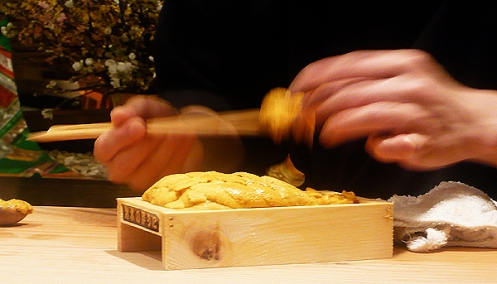
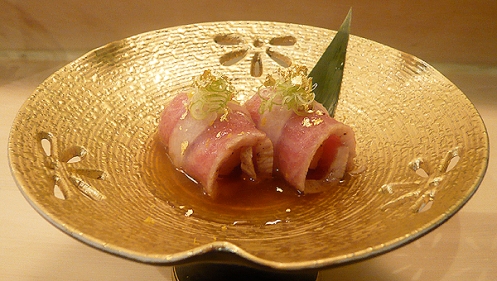



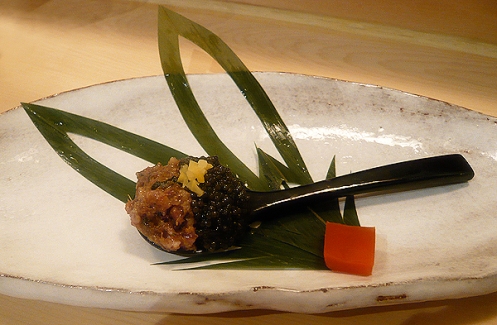




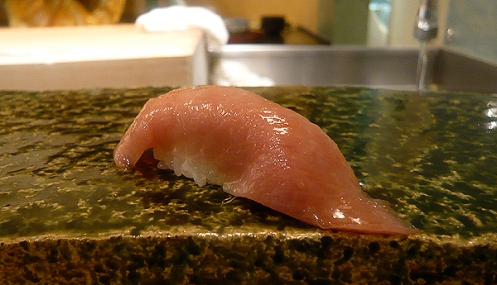
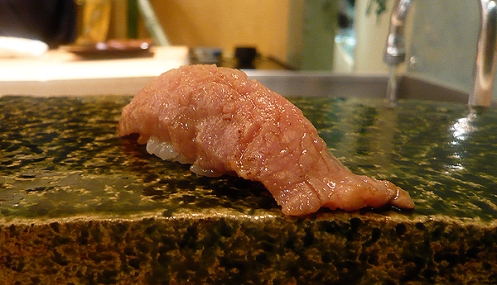
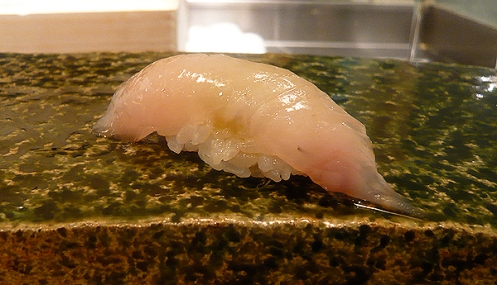





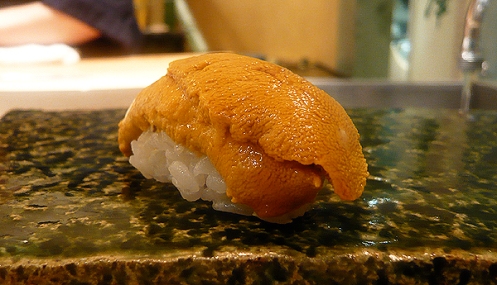



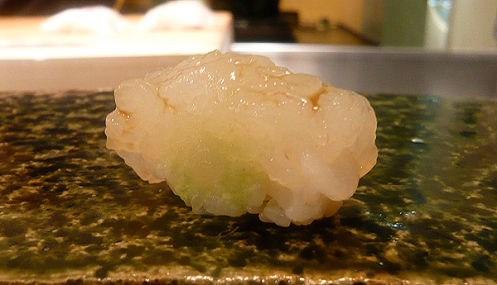


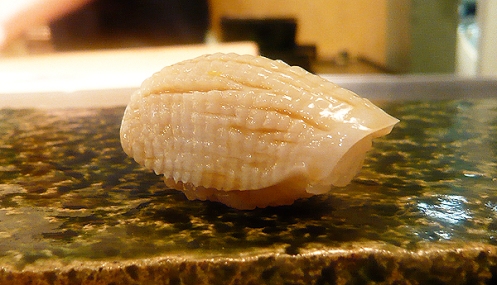



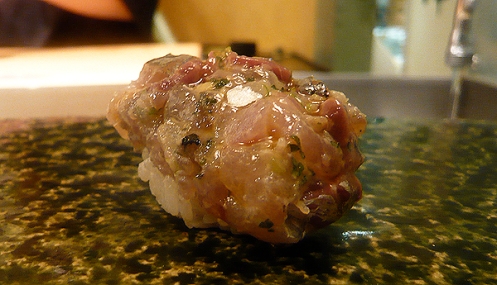


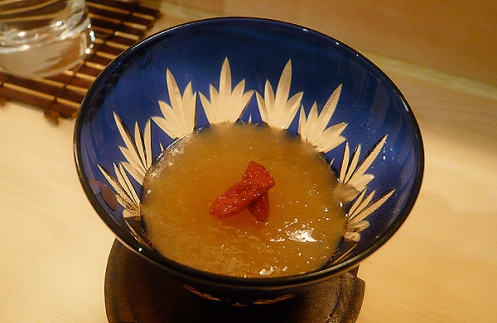










It looks amazing :) I wish we had such ambitious sushi restaurants overhere.
The meal you had at Urasawa makes my mouth water. Please check your blood level of mercury after such heavy duty fish consumption.
Flat out the most incredible Sushi Bar review in history! What a treat. I’m wondering if Hiro-san is the same one who started out years ago with a great place on Pacific Coast Hwy called “Something’s Fishy?” Thank you for the chance to see what $1200 brings in Bev Hills these days?
Thanks S.S, it was every bit as much of a treat eating it…although it does come with the price of knowing all the sushi I eat henceforth won’t be quite as good! (not sure if he started out at Something’s Fishy, but from what I read I’d say not…)
oh my god. all that gold. everything looks so delicious! and $1200! i’m glad you enjoyed it though! i loved all of your pictures!
That. Looks. Amazing. I am very jealous.
out of curiosity, where have you been in Japan? i thought Urasawa was the end-all but, upon visiting Japan, it was clear another level exists – in every variable – ingredient quality, rice quality, fish/rice ration, temp fish, etc, etc. (not to take *anything* away from Hiro – it’s just that Tokyo was *that* incredible.)
that said, Urasawa the experience is one of the best anywhere in the world. Great review.
Back while I was living in Asia (years before I started the blog) I used to fly to Japan once a year (my mother adores the country and even learnt to speak Japanese fluently) but would eat at obscure eateries and local haunts which I honestly wouldn’t tell you the names of. I do not doubt you’re right though, and we are planning to do a proper Japan trip sometime to seek out some stellar sushi and check out Nihonryori Ryugin and Kyoto Kitcho (among others) – any recommendations you may have would be much appreciated!
[…] most recent LA Survey – the man himself serves you upwards of 30 courses of nigiri, sashimi and maybe even chestnut pudding […]
Extreme Eating: Menus With at Least 15 Courses - Multi-City Restaurant Buzz - Zagat said this on June 25, 2010 at 5:21 pm |
[…] in London, we lack the likes of dedicated sushi bars such as Urusawa in LA (see Foodsnob and GT), where part of the charm – integral to the sushi experience – is the opportunity to […]
London Eater – London food blog and restaurant reviews and restaurant guide » Yashin Sushi: Raw Jewels. said this on November 15, 2010 at 2:25 pm |
My boyfriend and I are headed to Urasawa tomorrow night for his birthday. I don’t want to offend anyone, so I want to make sure I do what is appropriate. My question is about gratuity- what is the standard for a place like this?
I would say anything from 10-20%, depending on your experience that evening. have a great dinner – am sure it’ll be brilliant!